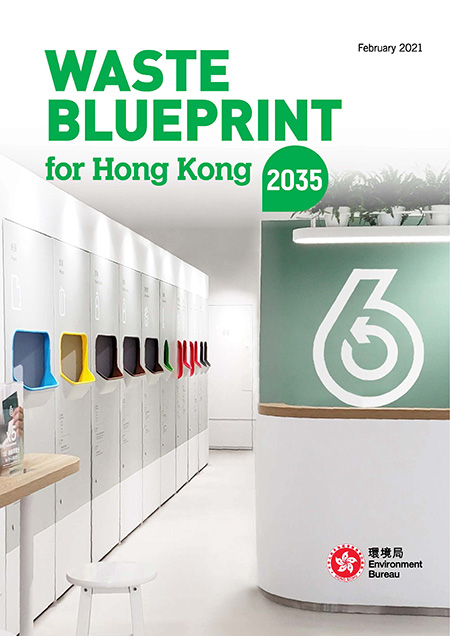This section aims to provide detailed information on waste generation, reduction and management in Hong Kong. An overview is given below for quick reference. Detailed information is organised into various categories, namely, Problems & Solutions, Data & Statistics, Public Consultation, Study Reports, Guidelines & References, Waste Reduction Programmes, Producer Responsibility Schemes, Waste Collectors & Recyclers and Waste Management Facilities which can be accessed through the menu.
AN OVERVIEW ON CHALLENGES FOR WASTE REDUCTION AND MANAGEMENT IN HONG KONG
WASTE BY TYPE
Hong Kong generates several different types of waste, and each has its own requirements for handling. The EPD keeps regular statistics on each waste type, such as composition, quantity sent for disposal and quantity recycled.
Municipal Solid Waste (MSW) comprises solid waste from households, commercial and industrial sources. This excludes construction waste, chemical waste, clinical waste and other special waste. MSW is disposed of at landfills.
Food waste is the major constituent of the municipal solid waste in Hong Kong. It comprises waste produced during food production, processing, wholesale, retail and preparation, as well as after meal leftovers and expired foods. It is highly degradable which can easily cause odour and hygiene problems.
Construction waste includes waste arising from construction work such as construction, renovation, demolition, land excavation and road works. Through waste sorting and separation, inert material is used as fill in reclamation sites, when available. The non-inert portion of the waste still goes to landfills.
Chemical waste comprises substances specified under the Waste Disposal (Chemical Waste) (General) Regulation as posing a possible risk to health and/or the environment.
Clinical waste consists of waste generated from various healthcare, laboratory and research practices as defined in Section 2 and Schedule 8 of the Waste Disposal Ordinance. It should be managed properly so as to minimize danger to public health or risk of pollution to the environment.
Waste Cooking Oils (WCO) include oils abandoned from any cooking process for human consumption, regardless whether they have been used for their original purposes (e.g. grease trap waste, used cooking oil and unused cooking oil abandoned for reasons such as spoilage), other than those from households. WCO should be handled properly to promote recycling of local resources and prevent them from re-entering the food chain.
Special wastes include animal carcasses, livestock waste, radioactive waste, grease trap waste, sewage sludge and waterworks sludges. These wastes need to be treated separately. Arrangements are being developed for the proper treatment and disposal of these wastes, but more time is needed to address community concerns about such facilities.
Other solid waste comprises dredged mud and excavated materials disposed of at marine disposal sites.
THE CHALLENGES
Waste is a common problem of affluent societies. Especially when people can afford greater convenience and more purchases, they tend to throw away more rubbish. Hong Kong is no exception to this.
Growing Wasteloads
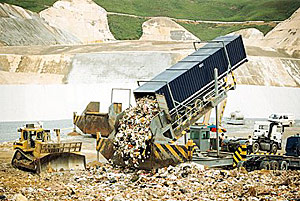
Hong Kong, like many developed places, has seen its wasteloads grow as its economy has grown. Municipal wasteloads have in general been increasing since 1986 - when the EPD was formed - mirroring Hong Kong's rapid economic expansion over the same period. At the same time, the population has grown by more than one million people and each person is throwing away more waste.
Municipal solid waste includes waste from households, industry and commercial operations, but landfills are also under tremendous pressure from construction waste.In 2006, the Government introduced the Construction Waste Disposal Charging Scheme and the quantity of construction waste disposed of at landfills has decreased largely since then. However, the disposal quantity fluctuates depending on the economic situation and the number of construction projects underway.
For detailed information on waste generation and disposal, please refer to Data & Statistics.
Outlook
There is limited land resource in Hong Kong. Landfills, which is an essential element of any sustainable waste management chain, need notable land resource on the other hand. Landfill space must be regarded as one of the city’s most precious assets, and therefore be more prudently used as a last resort.
Landfill space should also be conserved by state-of-the-art technologies that reduce the bulk volume of waste requiring disposal. After extensive review, the EPD is now planning to develop the Integrated Waste Management Facilities that would adopt advanced incineration as core technology to reduce bulk waste volume and to recover energy. Organic Resources Recovery Centres are also being planned to recycle source-separated organic waste to useful products.
WASTE REDUCTION
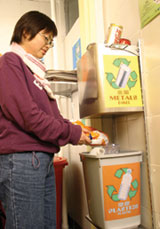
Waste recycling in housing estate
Waste reduction is often associated with recycling, but it is more complex than that. Avoiding the generation of waste in the first place and minimising waste are also crucial measures in any waste reduction strategy.
In May 2013, the Environment Bureau published the “Hong Kong Blueprint for Sustainable Use of Resources 2013–2022” (The Blueprint) which maps out a comprehensive strategy, targets, policies and action plans for waste management for the coming 10 years with a view to tackling the waste crisis in Hong Kong. The Blueprint set out the target to reduce the per capita disposal rate of Municipal Solid Waste (MSW) by 40% by 2022. To achieve this goal, the Blueprint proposes policies and actions in three areas, including to undertake multiple and concurrent actions to drive behavioural change to reduce waste at source through policies and legislation; to roll out targeted territory-wide waste reduction campaigns; and to allocate resources to enhance waste-related infrastructure.
Building on the “Hong Kong Blueprint for Sustainable Use of Resources 2013-2022”, the Government announced the “Waste Blueprint for Hong Kong 2035” in February 2021. Setting out the vision of “Waste Reduction ‧ Resources Circulation ‧ Zero Landfill”, the “Waste Blueprint for Hong Kong 2035” outlines the goals and measures to tackle the challenge of waste management up to 2035. It also sets out a long term target to move away from the reliance on landfills for direct disposal of MSW by around 2035. The Government’s strategy has two main directions. The first is to mobilise the entire community to practise waste reduction and waste separation for recycling in the upstream to reduce the overall waste disposal amount. The second is to proactively drive the development of downstream waste-to-energy (WtE) facilities for sustainable disposal of the remaining MSW.
To achieve “zero landfill” in a timely manner and continuously promote waste reduction at source, we will take forward waste reduction and recycling work along four directions – strengthening public education, enhancing recycling network, strengthening collaboration with industries, and utilising market forces to develop environmental infrastructure, in conjunction with the development of the WtE facilities I · PARK1 and the planned I · PARK2 to also reduce carbon emissions. MSW charging serves as a reserve tool. Should waste reduction and recycling yield results with sufficient public participation in the future, its implementation may not be required. The Government will continuously monitor the effectiveness of various waste reduction and recycling measures as well as the level of public support and participation in waste reduction and recycling, to assist in evaluating whether there is a need and conditions to conduct a trial on MSW charging in future.
As regards producer responsibility schemes (PRSs), the Environmental Levy Scheme on Plastic Shopping Bags (PSBs) commenced on 7 July 2009 as the first mandatory PRS under the Product Eco-responsibility Ordinance (Cap.603). It aims to reduce the indiscriminate use of PSBs through the implication of a direct economic disincentive. Riding on the effective reduction of PSBs distributed by sectors regulated under the scheme, we consulted the public on a proposal to further extending the scheme and received broad community support. With the approval by LegCo of the relevant legislative amendments, full implementation of the scheme to cover all retail outlets territory-wide took effect since 1 April 2015. For more details, please click here. EPD is also pressing ahead on the introduction of mandatory PRSs on waste electrical and electronic equipment (WEEE) and glass beverage containers for which legislative proposals have been introduced into the Legislative Council for scrutiny in March and July 2015 respectively. In parallel, we have been pursuing necessary complementary measures, including the development of the WEEE Treatment and Recycling Facility and the progressive expansion of the collection network for glass containers.
In order to enhance environmental education and assist local communities in the collection of various recyclables, thereby enabling green living to take root at the community level, the Government is progressively developing a Community Green Station (CGS) in each of the 18 districts, with each CGS operated by a non-profit-making organisation. As at end 2015, the first two CGSs in Sha Tin and Eastern districts have started operation, whilst projects in other districts are at different planning stages. For details, please click here.
The Environment and Conservation Fund (ECF) has allocated $10 million to support a public education programme under the Policy Framework. Interested parties may refer to relevant webpage for more details.
WASTE MANAGEMENT AND DISPOSAL
The EPD manages facilities for collecting, transferring, treating and disposing of a variety of waste types. Since 1989, the department has overseen the establishment of a Chemical Waste Treatment Centre, three strategic landfills and a network of refuse transfer stations. It has also phased out older, environmentally-unacceptable landfills, restored them to a safe condition and is in the process of developing them for different recreational uses, such as football pitches and golf courses.
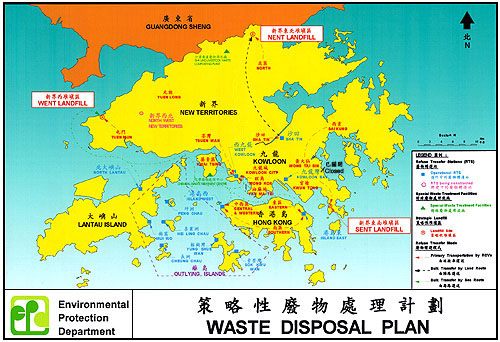
These waste facilities were built under the Waste Disposal Plan and cost more than $10 billion in total to build. The landfills initially were intended to last until 2020, but they could be full several years earlier if nothing is done to reduce wasteloads.
Waste is also managed through legislations. The Waste Disposal Ordinance is used to enforce controls on waste disposal, including collection and disposal and the import and export of waste. The Dumping at Sea Ordinance is enforced to control disposal of dredged mud and excavated materials at designated marine disposal sites. Livestock Waste Control Scheme has been fully implemented in the management and disposal of livestock waste.
The details of different types of waste management facilities are listed as follows :
- Three strategic landfills are located in the New Territories (Nim Wan, Tseung Kwan O and Ta Kwu Ling). Liners, leachate collection and treatment systems, landfill gas management systems, and surface and ground water management systems are in place to control air and water impacts.
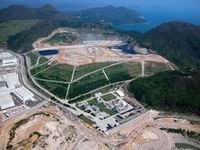
- Thirteen closed landfills in Hong Kong are being restored to minimise potential safety and health risks. They are landscaped to provide green zones and can be developed into different public recreational uses such as golf driving ranges and courses, multi-purpose grass pitches, recreational parks and ecological park.
- Seven refuse transfer stations are located in different areas in Hong Kong. These are centralised collection points for the transfer of waste to the strategic landfills. The waste from smaller refuse collection trucks is compacted and transferred into containers, which are loaded onto lorries or barges for shipment to landfills. The wastewater, odours and emissions from the stations are all controlled.
- The Chemical Waste Treatment Centre on Tsing Yi Island opened in 1993. It accepts a variety of chemical wastes and also clinical waste commencing 1 August 2011. It has extensive controls on its emissions which are regularly monitored by the EPD.
- The Sha Ling Composting Plant in the northern New Territories opened in 1991 and accepts livestock waste. The waste is composted into soil conditioner for use in Hong Kong.
- The Sludge Treatment Facility located at Tsang Tsui, Tuen Mun started operation in 2015. It receives and treats sewage sludge from 11 sewage treatment works of Drainage Services Department.
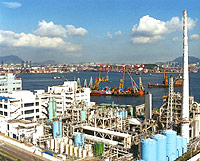
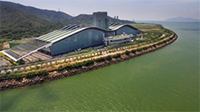
For further information on the impacts of these operations, see the EPD's Environmental Performance Report.
For detailed information on waste management and disposal, please refer to Problems & Solution.
THE SUSTAINABLE DEVELOPMENT OF RECYCLING INDUSTRY
EcoPark
To promote local recycling, the Government has developed a 20-hectare EcoPark in Tuen Mun Area 38 to provide long-term land at affordable costs for the development of the recycling industry with a view to encouraging investment in advanced technologies and valued-added recycling processes.
Recycling Fund
The $1 billion Recycling Fund has been launched in October 2015 and is open for applications. The Recycling Fund promotes the recovery and recycling of waste into useful resources and products by facilitating the upgrading of operational capabilities and efficiency of the recycling industry to support its sustainable development.
WHAT YOU CAN DO
Individuals can reduce their waste by buying items with less packaging, using reusable bags for shopping, and separating waste paper, metals and plastics from our daily waste for recycling.
Businesses can refer to the Hong Kong Awards for Environmental Excellence which encourages the private sector to organise their own waste reduction activities. The EPD also offers industry-specific information on waste reduction and outlets for recyclable materials. Please refer to Waste Reduction under Problems & Solutions for details.
Factories, trades, farmers and others also can refer to Guidelines & References for information on the legal requirements for disposing of waste.

Additionally, the EPD launched a territory-wide Programme on Source Separation of Domestic Waste in Januray 2005 which encourages housing estates/buildings to set up waste separation facilities on building floors and broaden the types of recyclables to be recovered, so as to increase domestic waste recovery and reduce waste requiring disposal. For more details, please click here or dial the Recycling Helpline (2838 3111). To further promote waste reduction and recycling and provide outlets for recyclables of low commercial value in the community, in 2011 the Government launched the Community Recycling Network. The EPD also conduct publicity and public education programmes to educate the public to reduce waste at source, separate waste properly to prevent contamination of recyclables, improve the quality of recyclables collected and lessen the burden of subsequent treatment.
Green Procurement
To promote waste reduction and recycling, the Government has been taking the lead in adopting a green procurement policy. For example, bureaux and departments are encouraged to avoid single-use disposable items, and purchase products with improved recyclability, higher recycled contents, less packaging and greater durability. For details, please visit Green Procurement.
